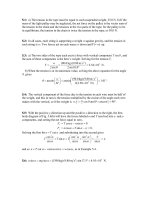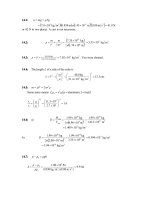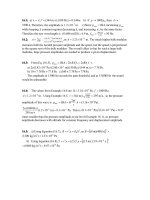- Trang chủ >>
- Khoa Học Tự Nhiên >>
- Vật lý
Tài liệu Physics exercises_solution: Chapter 01 ppt
Bạn đang xem bản rút gọn của tài liệu. Xem và tải ngay bản đầy đủ của tài liệu tại đây (375.72 KB, 38 trang )
1.1:
km61.1cm10km1.incm54.2ftin.12mift5280mi1
5
Although rounded to three figures, this conversion is exact because the given conversion
from inches to centimeters defines the inch.
1.2:
.in9.28
cm54.2
in1
L1
cm1000
L473.0
3
3
3
1.3: The time required for light to travel any distance in a vacuum is the distance
divided by the speed of light;
ns.103.33s1033.3
sm103.00
m10
36
8
3
1.4:
.
m
kg
1013.1
m1
cm100
g1000
kg1
cm
g
3.11
3
4
3
3
1.5:
L.36.5cm1000L1incm54.2in327
3
3
3
1.6:
.
.oz16
bottle1
gal1
.oz128
L788.3
gal1
m1
L1000
m1
3
3
bottles2112bottles9.2111
The daily consumption must then be
.
da
bottles
78.5
da24.365
yr1
yr
bottles
1011.2
3
1.7:
.hrkm2330mikm61.1hrmi1450
s.m648s3600hr1kmm10hrkm2330
3
1.8:
.
h
mi
67
h24
day1
day14
fortnight1
furlongs8
mile1
fortnight
furlongs
000,180
1.9:
.
gal
mi
3.35
gal1
L788.3
km1.609
mi1
L
km
0.15
1.10: a)
s
ft
88
mi1
ft5280
s3600
h1
hr
mi
60
b)
22
s
m
8.9
cm100
m1
ft1
cm48.30
s
ft
32
c)
3
3
3
3
m
kg
10
g1000
kg1
m1
cm100
cm
g
1.0
1.11: The density is mass per unit volume, so the volume is mass divided by density.
333
cm3077cmg5.19g1060 V
Use the formula for the volume of a sphere,
,
3
4
3
rV
to calculate
cm0.943:
3/1
Vrr
1.12:
%58.0100)s10(3.16s)10πs1016.3(
777
1.13: a)
%.101.1
m10890
m10
3
3
b) Since the distance was given as 890 km, the total distance should be 890,000
meters.
To report the total distance as 890,010 meters, the distance should be given as
890.01 km.
1.14: a)
2
mm72mm98.5mm12
(two significant figures).
b)
mm12
mm98.5
= 0.50 (also two significant figures).
c) 36 mm (to the nearest millimeter).
d) 6 mm.
e) 2.0.
1.15: a) If a meter stick can measure to the nearest millimeter, the error will be about
%.13.0
b) If the chemical balance can measure to the nearest milligram, the error will be
about
%.103.8
3
c) If a handheld stopwatch (as opposed to electric timing devices) can
measure to the nearest tenth of a second, the error will be about
%.108.2
2
1.16: The area is 9.69 0.07 cm
2
, where the extreme values in the piece’s length and
width are used to find the uncertainty in the area. The fractional uncertainty in the
area is
2
2
cm69.9
cm07.0
= 0.72%, and the fractional uncertainties in the length and width are
cm5.10
cm01.0
= 0.20% and
cm1.9
cm0.01
= 0.53%.
1.17: a) The average volume is
3
2
cm8.2cm050.0
4
cm50.8
π
(two significant figures) and the uncertainty in the volume, found from the extreme
values of the diameter and thickness, is about
3
cm3.0
, and so the volume of a
cookie is
.cm3.08.2
3
(This method does not use the usual form for progation of errors,
which is not addressed in the text. The fractional uncertainty in the thickness is so much
greater than the fractional uncertainty in the diameter that the fractional uncertainty in the
volume is
%10
, reflected in the above answer.)
b)
.20170
05.
50.8
1.18: (Number of cars
miles/car
.
day)/mi/gal = gallons/day
(2
10
8
cars
10000 mi/yr/car
1 yr/365 days)/(20 mi/gal) = 2.75
10
8
gal/day
1.19: Ten thousand; if it were to contain ten million, each sheet would be on the order
of a millionth of an inch thick.
1.20: If it takes about four kernels to fill 1 cm
3
, a 2-L bottle will hold about 8000
kernels.
1.21: Assuming the two-volume edition, there are approximately a thousand pages, and
each page has between 500 and a thousand words (counting captions and the smaller
print, such as the end-of-chapter exercise and problems), so an estimate for the number of
words is about
6
10
.
1.22: Assuming about 10 breaths per minutes,
6024
minutes per day, 365 days per
year, and a lifespan of fourscore (80) years, the total volume of air breathed in a lifetime
is about
35
m102
. This is the volume of a room
m20m100m100
, which is kind of
tight for a major-league baseball game, but it’s the same order of magnitude as the
volume of the Astrodome.
1.23: This will vary from person to person, but should be of the order of
5
101
.
1.24: With a pulse rate of a bit more than one beat per second, a heart will beat 10
5
times per day. With 365 days in a year and the above lifespan of 80 years, the number of
beats in a lifetime is about
9
103
. With
20
1
L (50 cm
3
) per beat, and about
4
1
gallon per
liter, this comes to about
7
104
gallons.
1.25: The shape of the pile is not given, but gold coins stacked in a pile might well be in
the shape of a pyramid, say with a height of
m2
and a base
m3m3
. The volume of
such a pile is
3
m6
, and the calculations of Example 1-4 indicate that the value of this
volume is
.106$
8
1.26: The surface area of the earth is about
2142
m1054 R
, where R is the radius of
the earth, about
m106
6
, so the surface area of all the oceans is about
214
m104
. An
average depth of about 10 km gives a volume of
324318
cm104m104
. Characterizing
the size of a “drop” is a personal matter, but 25
3
cmdrops
is reasonable, giving a total of
26
10
drops of water in the oceans.
1.27: This will of course depend on the size of the school and who is considered a
"student''. A school of thousand students, each of whom averages ten pizzas a year
(perhaps an underestimate) will total 10
4
pizzas, as will a school of 250 students
averaging 40 pizzas a year each.
1.28: The moon is about
mm104m104
118
away. Depending on age, dollar
bills can be stacked with about 2-3 per millimeter, so the number of bills in a stack
to the moon would be about 10
12
. The value of these bills would be $1 trillion (1
terabuck).
1.29:
.billsofnumber billArea USAofArea
.inhabitantmillion$3.6sinhabitant10 5.2bills109
bills109cm10m1cm6.7cm6.15kmm10km571,372,9
814
142422262
1.30:
1.31:
eastofnorth 38km,8.7
1.32:
a) 11.1 m @
o
6.77
b) 28.5 m @
o
202
c) 11.1 m @
o
258
d) 28.5 m @
o
22
1.33:
west.ofsouth 41m,144
1.34:
1.35:
m.6.937.0cosm0.12m,2.737.0sinm0.12;
yx
AAA
m.2.560.0sin m0.6m,0.360.0cosm0.6;
m.6.940.0sin m0.15m,5.1140.0cosm0.15;
yx
yx
CC
BB
C
B
1.36:
500.0
m2.00
m00.1
tan (a)
X
y
A
A
θ
2076.26180500.0tan
500.0
m2.00
m00.1
tan (d)
1536.26180500.0tan
500.0
m2.00
m00.1
tan )(
6.26500.0tan
500.0
m2.00
m00.1
tan (b)
3336.26360500.0tan
1
1
1
1
θ
A
A
θ
θ
A
A
θc
θ
A
A
θ
θ
x
y
x
y
x
y
1.37: Take the +x-direction to be forward and the +y-direction to be upward. Then the
second force has components
N4334.32cos
22
FF
x
and
N.2754.32sin
22
FF
y
The first force has components
.0andN725
11
yx
FF
N1158
21
xxx
FFF
and
N275
21
yyy
FFF
The resultant force is 1190 N in the direction
13.4
above the forward direction.
1.38: (The figure is given with the solution to Exercise 1.31).
The net northward displacement is (2.6 km) + (3.1 km) sin 45
o
= 4.8 km, and the
net eastward displacement is (4.0 km) + (3.1 km) cos 45
o
= 6.2 km. The
magnitude of the resultant displacement is
22
)km2.6()km8.4(
= 7.8 km, and
the direction is arctan
2.6
8.4
= 38
o
north of east.
1.39: Using components as a check for any graphical method, the components of
B
are
m4.14
x
B
and
m,8.10
y
B
A
has one component,
m12
x
A
.
a) The
-x
and
-y
components of the sum are 2.4 m and 10.8 m, for a magnitude
of
m,1.11m8.10m2.4
22
, and an angle of
.6.77
2.4
10.8
b) The magnitude and direction of A + B are the same as B + A.
c) The x- and y-components of the vector difference are – 26.4 m and
m,8.10
for a magnitude of
m28.5
and a direction arctan
.202
4.26
8.10
Note that
180
must be added to
22arctanarctan
4.26
8.10
4.26
8.10
in order to give an angle in the
third quadrant.
d)
.
ˆ
m8.10
ˆ
m4.26
ˆ
m0.12
ˆ
m8.10
ˆ
m4.14 jiijiAB
.2.22
26.4
10.8
arctanofangleandat m5.28m8.10m26.4Magnitude
22
1.40: Using Equations (1.8) and (1.9), the magnitude and direction of each of the given
vectors is:
a)
22
)cm20.5()cm6.8(
= 10.0 cm, arctan
60.8
20.5
= 148.8
o
(which is
180
o
– 31.2
o
).
b)
22
)m45.2()m7.9(
= 10.0 m, arctan
7.9
45.2
= 14
o
+ 180
o
= 194
o
.
c)
22
)km70.2()km75.7(
= 8.21 km, arctan
75.7
7.2
= 340.8
o
(which is
360
o
– 19.2
o
).
1.41:
The total northward displacement is
km,75.1km50.1km3.25
, and the total
westward displacement is
km4.75
. The magnitude of the net displacement is
km.06.5km75.4km1.75
22
The south and west displacements are the same, so
The direction of the net displacement is
69.80
West of North.
1.42: a) The x- and y-components of the sum are 1.30 cm + 4.10 cm = 5.40 cm,
2.25 cm + (–3.75 cm) = –1.50 cm.
b) Using Equations (1-8) and (1-9),
22
)cm50.1()cm04.5(
= 5.60 cm, arctan
40.5
50.1
= 344.5
o
ccw.
c) Similarly, 4.10 cm – (1.30 cm) = 2.80 cm, –3.75 cm – (2.25 cm) = –6.00 cm.
d)
22
)cm0.6()cm80.2(
= 6.62 cm, arctan
80.2
00.6
= 295
o
(which is 360
o
– 65
1.43: a) The magnitude of
BA
is
cm48.2
60.0sin cm90.10.60sincm2.80
60.0coscm90.160.0coscm80.2
2
2
and the angle is
18
0.60coscm90.160.0coscm2.80
0.60sincm90.160.0sin cm2.80
arctan
b) The magnitude of
BA
is
cm10.4
60.0sin cm90.10.60sincm2.80
60.0coscm90.160.0coscm80.2
2
2
and the angle is
84
0.60coscm90.160.0coscm2.80
0.60sincm90.160.0sin cm2.80
arctan
c)
.26418084isangle theandcm4.10ismagnitude the;
BAAB
1.44:
A
= (–12.0 m)
i
ˆ
. More precisely,
.180sinm012180cosm012 jiA
..
jijiB
ˆ
m8.10
ˆ
m4.14
ˆ
37sinm018
ˆ
37cosm018
..
1.45:
jijiA
ˆ
m6.9
ˆ
m2.7
ˆ
37.0cosm0.12
ˆ
37.0sinm0.12
jijiC
jijiB
ˆ
m2.5
ˆ
m0.3
ˆ
60.0sin m0.6
ˆ
60.0cosm0.6
ˆ
m6.9
ˆ
m5.11
ˆ
40.0sin m0.15
ˆ
40.0cosm0.15
1.46: a)
jijiA
ˆ
m38.3
ˆ
m23.1
ˆ
0.70sinm60.3
ˆ
0.70cosm60.3
jijiB
ˆ
m20.1
ˆ
m08.2
ˆ
30.0sin m40.2
ˆ
30.0cosm40.2
b)
BAC
00.400.3
ji
jiji
ˆ
94.14
ˆ
m01.12
ˆ
m20.100.4
ˆ
m08.200.4
ˆ
m38.300.3
ˆ
m23.100.3
(Note that in adding components, the fourth figure becomes significant.)
c) From Equations (1.8) and (1.9),
2.51
m12.01
m14.94
arctan m,17.19m94.14m01.12
22
C
1.47: a)
39.500.200.5 ,00.500.300.4
2222
BA
b)
jijiBA
ˆ
00.5
ˆ
00.1
ˆ
00.200.5
ˆ
00.300.4
c)
3.101
1.00-
5.00
arctan ,10.500.51.00
22
d)
1.48: a)
13111
ˆˆˆ
222
kji
so it is not a unit vector
b)
222
zyx
AAA A
If any component is greater than + 1 or less than –1,
1A
, so it cannot be a unit
vector.
A
can have negative components since the minus sign goes away when the
component is squared.
c)
125
10.40.3
1
2
2
2
2
2
a
aa
A
20.0
0.5
1
a
1.49: a) Let
,
ˆˆ
jiA
yx
AA
.
ˆˆ
jiB
yx
BB
jiAB
jiBA
ˆˆ
ˆˆ
yyxx
yyxx
ABAB
BABA
Scalar addition is commutative, so
ABBA
yyxx
yyxx
ABAB
BABA
AB
BA
Scalar multiplication is commutative, so
ABBA
b)
kjiBA
ˆˆˆ
xyyxzxxzyzzy
BABABABABABA
ˆˆˆ
kjiAB
xyyxzxxzyzzy
ABABABABABAB
Comparison of each component in each vector product shows that one is the
negative of the other.
1.50: Method 1:
θcosmagnitudesofoduct Pr
2
2
2
m5.71187cosm6m12cosAC
m6.1580cosm6m15cosBC
m4.993cosm15m12cosAB
θ
θ
θ
Method 2: (Sum of products of components)
2
2
2
m5.71)20.5(9.58)()0.3()22.7(
m6.15)20.59.64)(()0.311.49)((
m4.99.64)(9.58)((11.49)22.7
CA
CB
BA
1.51: a) From Eq.(1.21),
.00.1400.200.300.500.4 BA
b)
.7.58.5195arccos39.500.500.14arccosso,cosAB
θθBA
1.52: For all of these pairs of vectors, the angle is found from combining Equations
(1.18) and (1.21), to give the angle
as
.arccosarccos
AB
BABA
AB
yyxx
BA
In the intermediate calculations given here, the significant figures in the dot
products and in the magnitudes of the vectors are suppressed.
a)
,13,40,22 BABA
and so
165
1340
22
arccos
.
b)
,136,34,60 BABA
28
13634
60
arccos
.
c)
.90,0
BA
1.53: Use of the right-hand rule to find cross products gives (a) out of the page and b)
into the page.
1.54: a) From Eq. (1.22), the magnitude of the cross product is
2
m13037180sinm0.18m0.12
The right-hand rule gives the direction as being into the page, or the – z-direction. Using
Eq. (1.27), the only non-vanishing component of the cross product is
2
m13037sinm0.18m12
yxz
BAC
b) The same method used in part (a) can be used, but the relation given in Eq.
(1.23) gives the result directly: same magnitude (130 m
2
), but the opposite
direction (+z-direction).
1.55: In Eq. (1.27), the only non-vanishing component of the cross product is
,00.2300.500.300.200.4
xyyxz
BABAC
so
,
ˆ
00.23 kBA
and the magnitude of the vector product is 23.00.









